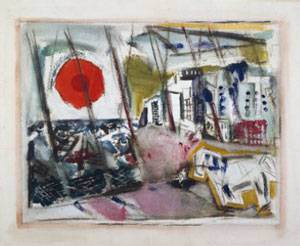
John Marin. The Red Sun-Brooklyn Bridge, 1922. Alfred Stieglitz Collection
‘John Marin’s Watercolors: A Medium for Modernism’ at the Art Institute of Chicago In 1948, a nationwide survey pronounced John Marin (1870–1953) “America’s Number 1 artist.” Marin’s exuberant and improvisational paintings are recognized today as critical to the evolution of American Modernis
January 23 through April 17, 2011
]]>
Source: Art Institute of Chicago
The exhibition is the result of a collaboration among curators, researchers, paper conservators, frameconservators, and conservation scientists, who used the latest analytical technology to examineMarin’s artistic practice in watercolor. Once associated with young women and amateur “Sundaypainters, ” the medium became in the hands of Winslow Homer and John Marin, became a theater forradical experimentation. For the first time, careful technical examination of a wide-ranging cache ofwatercolors reveals the artist’s working method, his modernist vision as it developed through etchingand into watercolor, and his exploitation of the inherent properties of the medium to craft a new avantgardevocabulary, which would in turn influence generations of American artists, including theAbstract Expressionists. By evaluating in depth the way Marin developed his modernist “tool kit,” thisexhibition reveals important intersections between media, artistic character, and the politics of modernart, shedding new light on the question of why watercolor became such an important instrument foravant-garde artistic practice in the hands of Marin and other American artists of the Stieglitz circle,including Charles Demuth, Arthur Dove, Georgia O’Keeffe, and Marsden Hartley
A notable aspect of the exhibition is the particular attention paid to the frames that Marin made for hiswatercolors. He felt strongly about the mode of presentation for the works, and his choices of framesand mounts departed radically from the ornate, European styles favored in the late 19th century. TheArt Institute collection—including the 40 works from Alfred Stieglitz’s personal collection via GeorgiaO’Keeffe—contains the largest surviving museum holdings of Marin’s original mounts and frames,thus providing essential evidence about the presentation and promotion of modern watercolor duringthe first half of the 20th century. The original frames and mounts have been researched andpreserved, and replica frames based on these models have been built for the works without originalframes, making the Art Institute’s presentation of these works as close to Marin’s intent as possibleand showing, for the first time, how Marin’s innovation and originality extended beyond his paintedcompositions.
Follow us on:


